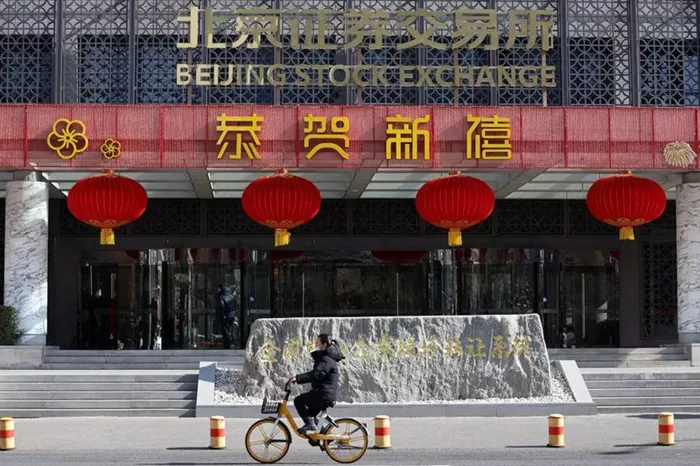Asian stock markets showed little movement on Monday, while the U.S. dollar strengthened, following warnings from President Donald Trump about imminent tariffs on steel and aluminum imports. The potential tariffs, which could escalate into a full-fledged trade war, raised concerns about inflation and limited the possibility of rate cuts by the Federal Reserve.
In comments made aboard Air Force One, Trump announced plans to impose a 25% tariff on all steel and aluminum imports into the United States, with further reciprocal tariffs expected to be revealed later in the week. This move coincided with German Chancellor Olaf Scholz’s statement that the European Union was prepared to respond within an hour if the U.S. imposed tariffs on European goods, heightening the risk of an escalating trade conflict.
Meanwhile, China’s retaliatory tariffs on U.S. exports were set to take effect on Monday, with little indication of progress in the ongoing trade talks between Beijing and Washington. Analysts are divided on whether these measures represent a strategic negotiating tactic by Trump or the beginning of a prolonged trade war. Stephen Dover, head of the Franklin Templeton Institute, noted that such tariffs could force U.S. businesses to either pass higher costs onto consumers, absorb the increased costs, or alter their supply chains altogether.
As the trade tensions increase, currencies in the affected countries may weaken against the dollar, as a way to mitigate the effects of the tariffs and keep their exports competitive. The tariffs could also add upward pressure on U.S. inflation, further limiting the Federal Reserve’s ability to lower interest rates. Following a strong payroll report last Friday, markets have already reduced their expectations for rate cuts this year to 36 basis points, down from 42 basis points.
Federal Reserve Chairman Jerome Powell is scheduled to testify before the House of Representatives this week, where the impact of tariffs on monetary policy is expected to be a key issue. His testimony will follow the release of January’s consumer price data, which may offer early indications of inflationary pressures resulting from the tariffs.
Dollar Strengthens Amid Trade Tensions
In response to the trade developments, the U.S. dollar gained ground. The dollar index rose to 108.265, while the euro fell 0.1% to $1.0315, and the Australian dollar weakened to $0.6270. The dollar also saw a 0.3% increase against the yen, climbing to 151.87.
In Asian markets, the MSCI Asia-Pacific index excluding Japan dipped 0.3%, while Japan’s Nikkei 225 gained 0.1%. South Korea’s main index declined by 0.1%, with losses in steelmakers leading the downturn. Chinese stocks showed little movement, though data indicating that consumer inflation in China accelerated in January helped ease deflation concerns.
The European stock markets saw modest gains, with Eurostoxx 50 futures rising 0.2%, FTSE futures increasing 0.2%, and DAX futures up 0.1%. Wall Street futures initially dropped but quickly recovered, with S&P 500 futures climbing 0.3% and Nasdaq futures rising by 0.5%.
Despite mixed earnings reports last week, overall earnings per share growth has been strong, running at 12%, surpassing initial expectations of 8%. However, analysts at Goldman Sachs warned that tariffs pose a significant downside risk to 2025 earnings per share (EPS) forecasts, with an estimated increase of 5 percentage points in the U.S. tariff rate, which could reduce EPS by 1% to 2%.
Inflation and Yield Pressures Affect Treasury Market
The looming threat of renewed inflation concerns has led to a rise in U.S. Treasury yields. The yield on 10-year U.S. Treasury notes increased to 4.490%, up from last week’s low of 4.400%.
However, despite these pressures on yields, gold prices reached record highs, climbing to $2,886 per ounce. This surge is partly driven by the prospect of tariffs on gold, prompting investors to seek physical gold in London to avoid new taxes, as evidenced by a shift from LME gold futures to Comex futures.
As for oil, prices saw a slight rebound following three weeks of losses. Brent crude rose 51 cents to $75.17 per barrel, while U.S. crude increased by 45 cents, reaching $71.45 per barrel. However, concerns about the potential impact of a trade war on global economic growth continue to weigh on oil demand.
Related topics:
- India Surpasses China in Gold Purchases, Buying 51% More in Three Months
- Gold Rates Skyrocket in Chennai on Diwali, 24K Gold Exceeds Rs. 81,000 Per 10 Grams
- Tariff Concerns Drive Gold Withdrawals from Bank of England Vault


